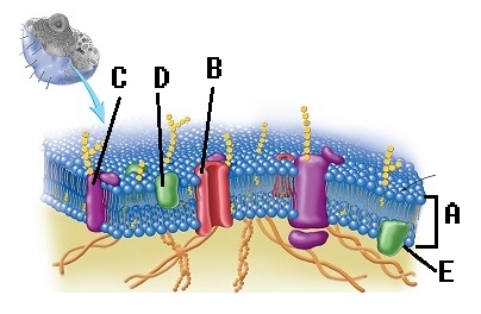A) pinocytosis.
B) biocytosis.
C) exocytosis.
D) calmly regulated diffusion.
E) phagocytosis.
G) B) and D)
Correct Answer

verified
Correct Answer
verified
Multiple Choice
All of the chemical reactions within a cell are known as cell
A) communication.
B) inheritance.
C) metabolism.
D) movement.
E) reproduction.
G) A) and E)
Correct Answer

verified
Correct Answer
verified
Multiple Choice
Which transport process requires a carrier molecule but does not use cellular energy?
A) diffusion
B) facilitated diffusion
C) osmosis
D) active transport
E) endocytosis
G) A) and B)
Correct Answer

verified
Correct Answer
verified
Multiple Choice
A person suffered burns over a large part of his body.Evaporation of fluid from the surface of burned areas occurs.As a result of the evaporation process,cells will tend to
A) first swell and then resume their original shape.
B) rupture.
C) swell.
D) remain unchanged.
E) shrink.
G) A) and C)
Correct Answer

verified
Correct Answer
verified
Multiple Choice
A protein that is converted to an active enzyme is a
A) codon.
B) proenzyme.
C) gene.
D) pre-mRNA.
E) ribosomal RNA (rRNA) .
G) All of the above
Correct Answer

verified
Correct Answer
verified
Multiple Choice
In the nucleus,DNA is wrapped with proteins.This complex is called
A) chromatin.
B) DNA particles.
C) nucleoli.
D) a DNA wrap.
E) cytoplasmic organelles.
G) B) and C)
Correct Answer

verified
Correct Answer
verified
Multiple Choice
Which of the following would increase the maximum rate of facilitated diffusion?
A) increase the concentration gradient of the transported molecule to the saturation point
B) decrease the concentration gradient of the transported molecule
C) increase the concentration of the competitive molecules
D) increased ATP synthesis
E) None of these choices is correct.
G) A) and E)
Correct Answer

verified
Correct Answer
verified
Multiple Choice
The movement of a substance from an area of high concentration to an area of less concentration is called
A) endocytosis.
B) osmosis.
C) diffusion.
D) facilitated diffusion.
E) active transport.
G) B) and C)
Correct Answer

verified
Correct Answer
verified
Multiple Choice
The movement of oxygen from the alveoli of the lungs into the bloodstream is an example of
A) osmosis.
B) active transport.
C) bulk transport.
D) facilitated diffusion.
E) diffusion.
G) B) and E)
Correct Answer

verified
Correct Answer
verified
Multiple Choice
What organelle contains the chromosomes?
A) centrioles
B) ribosomes
C) lysosomes
D) nucleus
E) mitochondria
G) A) and E)
Correct Answer

verified
Correct Answer
verified
Multiple Choice
 -What structure does "E" represent on the diagram of the plasma membrane?
-What structure does "E" represent on the diagram of the plasma membrane?
A) membrane channel protein
B) receptor protein
C) internal membrane surface
D) peripheral protein
E) phospholipid bilayer
G) C) and E)
Correct Answer

verified
Correct Answer
verified
Multiple Choice
What is a large,active phagocytic cell?
A) macrophage (large,mobile white blood cell)
B) columnar cells of small intestines
C) red blood cells
D) spermatozoa
E) columnar cells of upper respiratory tract
G) B) and C)
Correct Answer

verified
Correct Answer
verified
Multiple Choice
Which of the following terms does NOT relate to the mitochondria?
A) ATP
B) cristae
C) self-replicating
D) outer and inner membranes
E) vitamin A storage
G) B) and C)
Correct Answer

verified
Correct Answer
verified
Multiple Choice
Which of the following is CORRECTLY matched with its function?
A) peripheral proteins - penetrate the lipid bilayer from one surface to the other
B) nongated ion channels - are always closed
C) receptor proteins - attach to ligand molecules
D) channel proteins - are part of an intercellular communication system
E) marker molecules - are primarily steroids
G) A) and D)
Correct Answer

verified
Correct Answer
verified
Multiple Choice
A mitochondrial disease is passed to offspring via the father.
A) True
B) False
D) undefined
Correct Answer

verified
Correct Answer
verified
Multiple Choice
Three adjacent nucleotides in mRNA are called a
A) pre-mRNA.
B) gene.
C) codon.
D) ribosomal RNA (rRNA) .
E) proenzyme.
G) B) and E)
Correct Answer

verified
Correct Answer
verified
Multiple Choice
Osmosis is the diffusion of _____ across a selectively permeable membrane.
A) sugar
B) sodium
C) oxygen
D) urea
E) water
G) B) and C)
Correct Answer

verified
Correct Answer
verified
Multiple Choice
The transfer of information from DNA to messenger RNA (mRNA) is known as
A) transcription.
B) translocation.
C) translation.
D) transduction.
E) transmutation.
G) A) and B)
Correct Answer

verified
Correct Answer
verified
Multiple Choice
What is mediated transport?
A) The movement of molecules across a membrane by means of a protein carrier.
B) The process of peptide synthesis on the surface of the ribosome.
C) The ability of molecules to pass through the nuclear membrane.
D) The movement of vesicles by intermediate filaments.
F) A) and D)
Correct Answer

verified
Correct Answer
verified
Multiple Choice
Ribosomes are organelles responsible for
A) packaging "cell products" for export.
B) energy production.
C) cell movement and cell shape.
D) protein synthesis.
E) manufacturing lipids.
G) B) and D)
Correct Answer

verified
Correct Answer
verified
Showing 41 - 60 of 228
Related Exams